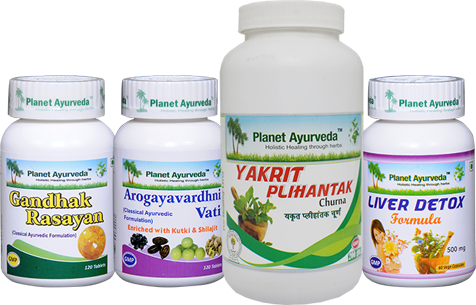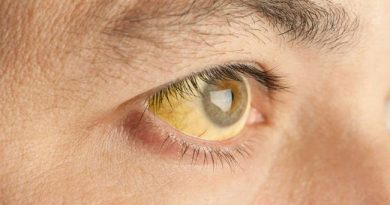Natural Ayurvedic Treatment for Gilbert Syndrome – Causes, Symptoms & Herbal Remedies
Abstract
Liver health is essential for the overall well-being, as the liver plays a key role in detoxification; metabolism of proteins, carbohydrates; breakdown of fats using bile; and the regulation of pigments like bilirubin. A healthy liver ensures proper digestion and helps maintain balanced levels of various nutrients and waste products in the body. There are various diseases that impact liver functioning. One such condition is Gilbert Syndrome. It is one of the most common inherited liver disorders, affecting approximately 3-10% of the population worldwide. It is also commonly seen in people with Type-1 Diabetes Mellitus.

Introduction
Gilbert Syndrome is an autosomal recessive disorder characterized by intermittent hyperbilirubinemia, where there is an excess of bilirubin in the bloodstream, causing jaundice. This condition is typically diagnosed in young adults and is often discovered accidentally during routine blood tests. This might remain asymptomatic throughout the life of the patient. It is caused by a modified gene which is in charge of bilirubin production in the liver. The risk of Gilbert’s is significantly higher in male than females and also in individuals whose both parents carry the mutated gene. This is a mild liver disease but can get aggravated if the patient is consuming jaundice increasing factors.
Causes
Gilbert Syndrome is caused by a genetic mutation in the UGT1A1 gene, which encodes the enzyme uridine diphosphate-glucuronosyltransferase (UGT). Normally, this enzyme is responsible for the conjugation of bilirubin in the liver, making it water-soluble and enabling its excretion in bile. But in individuals with Gilbert Syndrome, the UGT1A1 gene mutation leads to reduced enzyme activity, impairing bilirubin conjugation. As a result, the unconjugated bilirubin starts accumulating in the bloodstream. The symptoms can worsen when jaundice is triggered in situations like starvation, dehydration, viral infections, excessive alcohol consumption, chemotherapy medications, and many other factors.
Symptoms
Most cases remain asymptomatic but sometimes symptoms can develop when bilirubin levels are elevated.
- Jaundice: The hallmark symptom of Gilbert Syndrome is intermittent jaundice, which occurs due to elevated levels of unconjugated bilirubin in the blood. In this yellowing of the skin or eyes (in sclera) is seen.
- Fatigue: Feeling of tiredness is present, although it is not severe enough to interfere with daily activities.
- Nausea: Mild nausea is present during episodes of jaundice.
- Abdominal discomfort: a vague abdominal discomfort, particularly in the upper right side of abdomen is seen.
- Indigestion & IBS like symptoms can be sometimes present.
- Brain fog: difficulty in thinking clearly.
Diagnosis
- Blood Tests: A regular CBC & LFT are done which will indicate elevated bilirubin levels.
- Genetic testing is done for a confirmatory diagnosis.
- In rare cases, liver biopsy is advised to rule out other conditions.
Treatment
In cases where patients are completely asymptomatic, no treatment is required. Treatment of Gilbert Syndrome is only advised when symptoms are present due to increased bilirubin.
- Medicines of class barbiturates, high-dose salicylates, ursodeoxycholic acid, caffeine, penicillin etc. are helpful in decreasing bilirubin levels.
- Avoidance of triggers like physical exhaustion, fasting, stress, alcohol consumption should be avoided.
- Eating your meals timely and staying hydrated is necessary.
Ayurvedic Overview
In Ayurveda, we can understand Gilbert’s Syndrome as a disease of the yakrit (liver) and pleeha (spleen). It is a tridoshaj vikara (disease) with the dominance of pitta dosha. Here our pitta dosha is involved as both Yakrit and Pleeha are considered as the location of pitta dosha. In Gilbert’s specifically ranjaka pitta dushti (bile) is seen which further affects our Bhrajak pitta which is present in skin.
The main symptom of jaundice in this disease can be co-related to Kaamla as per ancient ayurvedic texts. The dushta pitta aggravates in rakta and mamsa dhatu which further causes “Vivarnta” (discoloration) in skin.
हारिद्रनेत्रः स भृशं हारिद्रत्वङ्नखाननः|(C. Chi. 16/ 35)
In this, there is yellowish discoloration of eyes, nails, face and skin.
The treatment is based on balancing the vikrita pitta dosha (morbid pitta).
शुष्कमूलककौलत्थैर्यूषैश्चान्नानि भोजयेत्||
मातुलुङ्गरसं क्षौद्रपिप्पलीमरिचान्वितम् |
सनागरं पिबेत् पित्तं तथाऽस्यैति स्वमाशयम् || (C. Chi. 16/ 129-130)
The diet given to patients should be dry, sour and pungent in qualities. Also the soups made up of mooli (radish) and kulatha (horse gram) are advised. The juice of lemon is taken along with honey, Pippali (Piper longum), Maricha (Piper nigrum), Shunthi (Zingiber officinalis) for balancing pitta.
Herbal Remedies for Gilbert Syndrome by Planet Ayurveda
Planet Ayurveda provides a combination of ayurvedic herbs for the management of Gilbert Syndrome. The medicines beneficial in Gilbert Syndrome are Yakrit Plihantak Churna, Arogyavardhni Vati, Liver Detox Capsules and Gandhak Rasayan. All the Planet Ayurveda medicines are 100% natural, vegetarian, additive free, chemical & preservative free and without any side effects. With ayurvedic intervention, the Gilbert Syndrome can be managed efficiently.
Herbal Remedies for Gilbert Syndrome


Product Description
1. Yakrit Plihantak Churna
This churna is made using a standardized extract of Ayurvedic herbs such as Bhumi amlaki (Phyllanthus niruri), Bhringraj (Eclipta alba), Katuki (Picrorhiza kurroa), and Kalmegha (Andrographis paniculata), which are known to aid in the repair and reversal of liver damage. All of these herbs possess pitta-balancing properties. Bhringraj (Eclipta alba) plays a key role in reducing fat buildup in the liver and promoting the regeneration of liver cells (hepatocytes).
Dosage: 1 tsp twice a day with lukewarm water.
2. Arogyavardhini Vati
This traditional herbo-mineral formulation is available in tablet form and is made from standardized extracts of herbs such as Katuki (Picrorhiza kurroa), Triphala (Three myrobalans), Chitrak Mool (Plumbago zeylanica), purified Guggul (Commiphora mukul), and purified Shilajit (Asphaltum). Additionally, it includes bhasma (ash) made from the Ayurvedic purification of various metals like mercury, sulfur, iron, copper, and mica. This potent preparation is used for a wide range of health conditions, including obesity, fever, liver diseases, digestive issues, skin disorders, hyperlipidemia, diabetes, autoimmune conditions, and more. It helps balance the three doshas. The tablets are often taken alongside other medicines to enhance their absorption. Known for its “Ama Pachana” properties, it supports digestion and helps eliminate toxins from the body.
Dosage: 2 tablets twice a day.
3. Liver Detox Capsules
This formula is available in capsule form and is made using standardized extracts from herbs like Katuki (Picrorhiza kurroa), Punarnava (Boerhavia diffusa), Makoy (Solanum nigrum), Haritaki (Terminalia chebula), Kasni (Cichorium intybus), and other similar herbs. This powerful blend aids in detoxifying and fortifying liver cells (hepatocytes), ultimately supporting the restoration of liver health.
Dosage: 2 capsules twice a day
4. Gandhak Rasayan
These tablets are traditional herbomineral formulations made from purified sulphur, which undergoes a thorough Shodhana (purification) process using cow’s milk. In addition, they contain standardized extracts from various herbs such as Twak – Cinnamomum zeylanicum, Ela (Elettaria cardamomum), Patra (Cinnamomum tamala), Nagakesar (Mesua ferrea), Triphala (Three myrobalans), Guduchi (Tinospora cordifolia), Shunthi (Zingiber officinalis), and Bhringraj (Eclipta alba). This powerful combination offers antimicrobial and rejuvenating (rasayanic) properties that are beneficial for skin. The use of sulphur for skin health has been recognized for centuries, with ancient practices recommending baths in sulphur-rich water to treat skin issues.
Dosage: 2 tablets twice a day.
Conclusion
Gilbert Syndrome is a mild, genetic liver disorder that typically does not cause any serious health problems. It is characterized by intermittent jaundice and mild elevation in bilirubin levels. While the condition can be triggered by certain factors such as fasting, illness, or stress, it is usually benign and does not lead to any long-term complications. Although the condition is generally harmless, understanding its pathophysiology, clinical features, and management is important to ensure the quality of life for those affected. With the proper lifestyle modifications like awareness about the condition, regular monitoring, and avoiding known triggers are the most effective ways to manage the syndrome individuals with Gilbert Syndrome.




